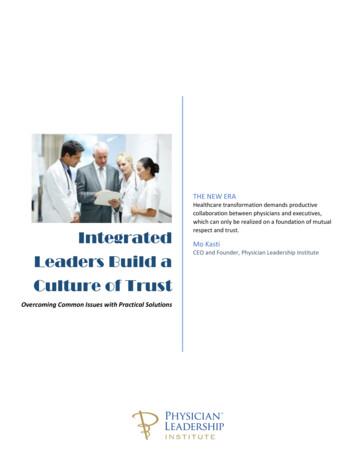
Transcription
THE NEW ERAIntegratedLeaders Build aCulture of TrustOvercoming Common Issues with Practical SolutionsHealthcare transformation demands productivecollaboration between physicians and executives,which can only be realized on a foundation of mutualrespect and trust.Mo KastiCEO and Founder, Physician Leadership Institute
Integrated Leaders Build a Culture of TrustOvercoming Common Issues with Practical SolutionsLeadership Then and NowIntegrated leadership in healthcare refers to collaboration between an organization’s executivemanagement team and its physicians. During the long period of transactional, fee-based healthcareservices, health system administrators and physicians co-existed within a framework to provide care, buttheir decision-making responsibilities were separate and entirely different.Healthcare executives looked after the business of providing care within the structure of an organization,which included only minimal interaction with physicians who treated their patients within the hospital orhealth system facility. The hospital or health systems provided the space and resources, the physiciansprovided the clinical expertise, and both were paid according to their contributions.A New EraThe demand for value-based accountable care has changed all that. Healthcare institution executivesand physicians are now mutually responsible for delivering better outcomes at lower costs. This can onlyhappen through meaningful collaboration, or integrated leadership.Because hospitals and doctors have traditionally operated quite independently of one another, theyhave separate professional associations – the American Hospital Association (AHA) and the AmericanMedical Association (AMA), each of which represents the interests of their members and theirmembers’ patients.Industry Leaders on LeadershipA clear and positive sign that we truly are entering a new era in healthcare came with the recentcollaboration between the AHA and the AMA on a set of guiding principles for achieving successfulintegrated leadership within hospitals and health systems. Integrated leadership for Hospitals andHealth Systems: Principles for Success is the result of a three-year effort to provide guidance on bestpractices for re-imagining traditional relationships between physicians and hospital executives.The Physician Leadership Institute (PLI) applauds AMA and AHA for turning their shared vision intoaction-oriented guiding principles:1.2.3.4.5.6.Alignment between hospital leaders and physiciansAn interdisciplinary structure that supports collaboration in decision makingIntegrated Clinical and hospital leadershipA collaborative, participatory partnership built on trustOpen and transparent sharing of informationA clinical information system infrastructurePLI concurs with these principles and, as an early advocate for purposeful and targeted leadershipdevelopment of physicians and administrators, we are delighted to have these two great organizationsvalidate our cause. The three key elements in the published guidelines: physician organization,leadership development, and cultural adaptation; align perfectly with our mission to empowerphysicians and administrators with the leadership and cultural skills they need to lead the healthcaretransformation.1 2015 Center for Transformation and Innovation, Physician Leadership Institute
Leadership & TrustAn extremely important point made by AHA and AMA is that “a common thread for successfulhealthcare organizations is integrated healthcare leadership between physicians and administrativecolleagues that involves a functional trust-based partnership.”Without trust, there is no alignment, without alignment, there is no engagement, and withoutengagement, there can be no transformation. Functional trust-based partnerships between physiciansand hospital executives hinge upon the ability of each partner to work together, in service of sharedclinical and business priorities.Of course, the priorities are many in healthcare and, understandably enough, physicians and executivesboth tend to be more focused on what needs to be done from a logistical and process perspectivewithout recognizing where the true obstacles may lie. So much is happening beneath the surface in anyhealthcare system and we ignore these elements at our peril.The Trust IcebergThe priorities above the water line get most of the time and attention, but the below-the-line elementscomprise the hidden bulk of the iceberg. The tasks that have to be accomplished in order to transformstructure, standards, processes, and, ultimately, outcomes require a culture of collaboration and sinceretrust. Unless and until that trust is established and physicians and executives lead the way together,sharing a vision and values, the list of tasks-to-be-completed for healthcare transformation will never becompleted.2 2015 Center for Transformation and Innovation, Physician Leadership Institute
Trust Issues and SolutionsTrust IssuePotential SolutionRisk Aversion: Due to the fragmentation of thehealthcare industry, trust and collaboration arenot natural among any of the variousstakeholders, beginning with hospitals andphysicians, but also including government, healthplans, and payers. Risk is being shifted amongthese participants and all are nervous about thefuture and hesitant to rely on others for theirown security.Physician Employment: A tendency forresentment amongst physicians who value theirautonomy and do not like to be treated as“employees” is quite common. This creates abarrier between individual priorities andorganizational objectives—usually furtherexacerbated by a lack of trust.Lack of Respect for Other Roles: Unfortunately,talking over one another rather than to oneanother has become commonplace betweenphysicians and executives. Alignment betweenindividuals and the goals of the organizationremains a huge challenge when doctors who takeleadership roles are regarded as “sellouts” orlabeled “gone to the dark side,” whileadministrators are derided as “know-nothings”and physicians are seen as obstacles to, ratherthan instruments of, positive transformation.New Mindset: Integrated leaders come togetherand publicly commit to an organizationwide growth and abundance mindset tocounteract and replace a culture of blame andmistrust. Physicians and administrators should bepurposeful in setting the collaborative tone forthe desired culture and address their concernsabout risk openly and then work to mutuallyacceptable solutions.The Right People: Employ the deliberateselection and on-boarding of leadership partners– use behavioral based interviewing inthe selection process. Select for cultural fit asmuch as technical skills. Consider the AMA’sPrinciples for Physician Employment.Failing to Recognize Others: A consequence ofthe expert culture vs. collaborative culture inhealthcare is the inability of physicians andadministrators to appreciate the contribution ofothers in achieving success, which, in turn, makesit all the more difficult to take advantage ofstrengths and build collaborative teams.Lack of Self-Awareness and low EQ: Neithermedical schools nor MBA programs focus on thevalue of self-awareness and emotionalintelligence, both of which are essential tobuilding relationships and trust.Right from the Start: A structured onboardingprocess makes it possible for physiciansand administrators to start fresh together ina partnership from the start. Introduction to theroles and perspectives of others can be an eyeopening experience and makes the next step ofparticipating in reciprocal business and clinicalacumen training infinitely more productive.Developing shared goals between employee andemployer through cooperative, trust-basedexercises as early as possible will pay benefits farinto the future.Practice Together: Practice collaboration byworking on strategic action projects whereleaders build trust, band together to garnersupport elsewhere in the organization, establishcollaborative goals, and share power. Also, timetogether working on leadership skills andstrategies allows physicians and administratorsto get to know and appreciate one another’stalents.A confidential 360 assessment immediatelyfosters better self-awareness and allowsindividuals to reveal vulnerabilities to colleagues,which builds trust.3 2015 Center for Transformation and Innovation, Physician Leadership Institute
Conclusion & Next StepsTo develop productive partnerships, physicians and administrators need a deliberate structure andexperience to create the opportunities to build relationships, get to know one another, and build trust.The six principles and three key elements outlined by the AHA and AMA serve as an excellent guide tobegin.For assistance with next steps, Physician Leadership Institute provides education and tools for physicianleaders to not only make transformation happen, but to make it stick. We offer concise butcomprehensive strategy maps and other essential education for change agents.The AHA has exclusively endorsed the Physician Leadership Institute for physician leadership trainingbecause “they have a proven track record of empowering physicians with necessary leadership skills toinitiate change.”The Physician Leadership Institute offers: Exclusive focus on physician leadership development, which ensures deep knowledge of hospitaland physician challenges and trends Effective results, which include physicians’ personal and professional growth, improvedphysician engagement and performance, and better long-term succession planning. All programs designed to protect physician productivity and implement a lasting culture ofcollaborative leadership and trust.For a detailed look inside The Physician Leadership Institute ProgramVISIT WWW.PHYSICIANLEADERSHIP.ORGCenter for Transformation and Innovation3802 Spectrum Blvd., Ste. 116ATampa, FL ysician Leadership Training and Development Services from The Physician Leadership Institute haveearned the exclusive endorsement of the American Hospital Association4 2015 Center for Transformation and Innovation, Physician Leadership Institute
integrated leadership within hospitals and health systems. Integrated leadership for Hospitals and Health Systems: Principles for Success is the result of a three-year effort to provide guidance on best practices for re-imagining traditional











